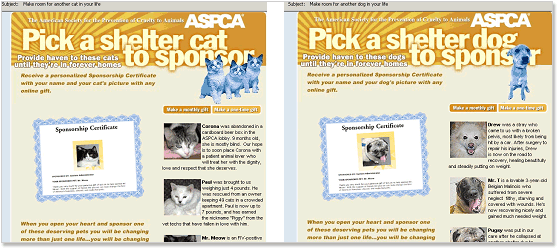|
Donor Treatment — The Real Impact of the Internet by Vinay Bhagat, Founder and Chief Strategy Officer, Convio
Many readers of this newsletter rely heavily on direct mail fundraising as a major source of revenue. The economics of direct mail fundraising (i.e., the cost to produce and send a piece of mail) requires an approach focused on solicitation. Through virtually every piece of mail they send, nonprofits solicit a contribution. General updates or newsletters invariably contain a “soft ask” to cover production and mailing costs. Even sending acknowledgements frequently has to be internally cost-justified (see Mal Warwick’s article in Vol. 7, Number 2, of the Journal of the Direct Marketing Association Nonprofit Federation). The primary performance metric for direct mail fundraising is response rate to the current appeal. In this context, there is very little meaningful focus on treating a donor or prospect like a valued customer. That would entail communicating more than soliciting, learning what is important to constituents and treating each constituent as an individual. Nonprofits typically reserve this type of treatment for high-value donors and prospects because it is expensive and resource-intensive. Although direct mail fundraisers monitor donor retention rates and aggregate contributions over time, their primary emphasis remains response management. The Internet and innovations in technology turn this approach on its head. Through email, groups now can communicate with donors and prospects at close to zero cost. Acknowledgements and general updates no longer have to be cost-justified. Furthermore, online Constituent Relationship Management (eCRM) technology makes it easy to learn what is most important to donors and personalize updates and appeals according to their interests and giving history. While designing and executing effective appeals is still critically important, fundraisers need to embrace a donor development strategy and measurement system that prioritizes donor treatment. Chicago Public Radio is an example of an organization that has seen strong results through focusing on donor/member treatment using the Internet. Historically, a major challenge for public broadcasting stations has been retention of first-year members. Sending members a high quality email newsletter has helped Chicago Public Radio grow first-year member retention rates. Those members who received the newsletter renewed at a 20 percent higher rate than those who did not. Through its email newsletter, the station also engages members in dialog through online surveys and promotes special opportunities, including events. The American Society for the Prevention of Cruelty to Animals (ASPCA), one of the nation’s leading animal welfare organizations, has also achieved very positive results by focusing on donor treatment. Donors with email addresses receive frequent email updates that explain how the ASPCA is using their dollars and fulfilling its mission. These communications encourage visits to the organization’s Web site (http://www.aspca.org/) to get more information, share stories about animal adoption successes and engage in advocacy. Additionally, the ASPCA has worked to capture constituent information on pet preferences so it can personalize communications, including appeals, based on interests. These strategies are working. In the last two years, the segment of donors receiving regular email communications has given 2.1 times as much as those who do not, primarily driven by higher giving frequency. While there may be intrinsic loyalty differences for donors who volunteer their email addresses, this only explains part of the delta. There is strong evidence to suggest that higher levels of online donor service are having a perceptible impact. For example, donors opting to renew online have increased their average gifts by more than 40 percent. Additionally, donors receiving targeted appeals based upon their pet preferences (fig. 1) have responded at two to three times the rate of those receiving neutral — or non-pet-specific — messages.
Fig. 1: Aligning appeals to donor interests through eCRM technology
These organizations will formulate a communications and constituent development strategy that systematically furthers the affinity and involvement of prospects and donors with their cause. They will:
Nonprofits with this vision will generate financial benefits far beyond increases in online contributions. They will yield meaningful lifts in donor retention rates and per-donor contribution, and systematically raise the value of their email file. At the same time, they will have donors who are more satisfied, informed and committed. Have a colleague who might be interested in this topic? Why not forward this article?
|
|


 Many of today’s nonprofit organizations are starting to raise a significant amount of funds online. According to the June 10, 2004 issue of The Chronicle of Philanthropy, in 2003, online fundraising, as measured by dollars contributed over the Internet, surged, increasing by 48 percent at the 146 organizations that provided figures for 2003 and 2002. Although such growth is exciting, it should not be the primary metric by which online strategies are formulated and results measured. The primary goal should be to improve the organization’s treatment of donors and prospects, thereby forging long-term, high revenue-generating relationships, irrespective of how people choose to give (i.e., through the mail, in-person, by telephone, online, etc.).
Many of today’s nonprofit organizations are starting to raise a significant amount of funds online. According to the June 10, 2004 issue of The Chronicle of Philanthropy, in 2003, online fundraising, as measured by dollars contributed over the Internet, surged, increasing by 48 percent at the 146 organizations that provided figures for 2003 and 2002. Although such growth is exciting, it should not be the primary metric by which online strategies are formulated and results measured. The primary goal should be to improve the organization’s treatment of donors and prospects, thereby forging long-term, high revenue-generating relationships, irrespective of how people choose to give (i.e., through the mail, in-person, by telephone, online, etc.).

